Palmer List of Merchant Vessels
[?Norwegian ship] CAESAR [1861] -
See: HOWARD (1846)
CALEDONIA (1863)
The steamship CALEDONIA was built for Henderson Bros (known
familiarly, and from 1899 officially, as the Anchor Line) by Tod &
McGregor, Glasgow, and was launched on 29 October 1863. 1,393 tons; 79,70
x 10,09 meters / 261.5 x 33.1 feet (length x breadth); clipper bow, 1 funnel,
2 masts; iron construction, screw propulsion, 2 cylinder inverted engine,
service speed 10 knots; accommodation for 40 passengers in 1st class, 90 in
2nd class, and 300 in steerage.
The CALEDONIA was the second vessel of this name built for the
Anchor Line by Tod & McGregor within 18 months. 11 December 1863, maiden
voyage, Glasgow - Portland, Maine - New York. 1863-1872, Glasgow-New York
service, except 1 roundtrip voyage Feb 1870, Glasgow- Palermo (departed 14
March) - New York - Glasgow. 1872, lengthened to 94,66 meters (310.6 ft);
2,125 tons; compound engines; accommodation for 60 passengers in 1st class
and 550 in steerage. 10 July 1872, resumed Glasgow - Moville - New York
service. August 1874, first voyage, Glasgow- Genoa (departed 25 August) -
Naples - New York - Glasgow (2 roundtrip voyages). March 1875, single
roundtrip voyage, Glasgow - Liverpool - Bombay (first voyage of Anchor Line
service). 1875-1880, Glasgow - Mediterranean - New York - Glasgow. 1880-1881,
8 roundtrip voyages, London - Halifax - Boston. 1881-1884, resumed Glasgow -
Mediterranean - New York - Glasgow service. 1884-1886, 11 roundtrip voyages,
London - Halifax - Boston. 1886-1896, resumed Glasgow - Mediterranean - New
York - Glasgow service. 6 May 1896, last voyage, Genoa - Naples - New York
(arrived 19 June) - Glasgow. 23 April 1897, scrapped in Italy.
Source: Noel Reginald Pixell Bonsor, North Atlantic Seaway; An
Illustrated History of the Passenger Services Linking the Old World with the
New (2nd ed.; Jersey, Channel Islands: Brookside Publications), vol. 1
(1975), p. 451.
Voyages:
- Anchor Line steamship CALEDONIA, Capt. McDonald, arrived at New
York on 23 June 1868, from Glasgow 5 June 1868, via Moville, with
merchandise and 597 passengers, to Henderson Bros; "[e]xperienced
strong westerly gales throughout, and fog during the last 6 days".
[07 Jul 1999]
|
CALIFORNIA (1848)
[Right] Print of the CALIFORNIA.
Peabody Essex Museum, Salem,
Massachusetts. Source: Edwin L. Dunbaugh and William duBarry Thomas,
William H. Webb: Shipbuilder (Glen Cove, New York: Webb
Institute of Naval Architecture, 1989), p. 172. To request a larger
copy of this scan, click on the picture.
|
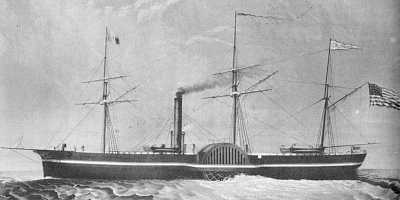
|
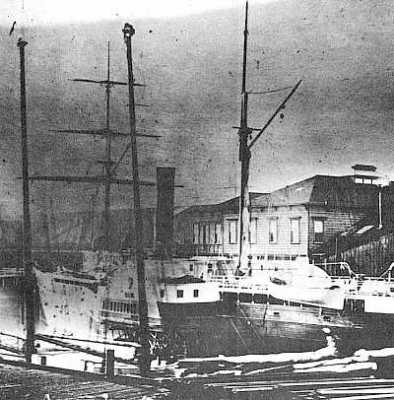
|
[Left] Photograph of the CALIFORNIA, taken prior
to 1870, at a pier in San Francisco.
The Mariners' Museum, Newport
News, Virginia. Source: Edwin L. Dunbaugh and William duBarry Thomas,
William H. Webb: Shipbuilder (Glen Cove, New York: Webb
Institute of Naval Architecture, 1989), p. 174. To request a larger
copy of this scan, click on the picture.
|
The steamship CALIFORNIA was built by William H. Webb, New
York (hull #37), for the Pacific Mail Steamship Co; keel laid 4 January
1848, launched 19 May 1848. 1,057 64/95 tons; 199 feet 2 inches x 33
feet 6 inches x 20 feet (length x breadth x depth of hold); 2 decks, 3
masts, round stern, sharp tuck, billethead; wooden construction,
side-wheel propulsion, side-lever engine from Novelty Iron Works, NY,
diameter of cylinder 1 foot 5 inches, length of stroke 8 feet; draft
when fully loaded, 15 feet 8 inches; cost $200,082.
The CALIFORNIA sailed from New York on 5 October 1848, and
reached San Francisco on 28 February 1849, the first American steamer
to pass through the Straits of Magellan and the first steamship to enter
the Golden Gate. The CALIFORNIA operated regularly between San
Francisco and Panama from 1849 to 1854, and then served in a reserve
capacity until the 1870's, when her engines were removed and her hull sold
to N. Bichard, of San Francisco, who rigged her as a bark, and placed her
in the coal and lumber trade. In late December 1894/early January 1895,
she was wrecked near Pacasmayo, Peru, bound from Port Hadlock, Washington,
with a cargo of lumber.
Sources: John Haskell Kemble, The Panama Route, 1848-1869,
University of California Publications in History, 29 (Berkeley:
University of California Press, 1943), p. 218; Edwin L. Dunbaugh and
William duBarry Thomas, William H. Webb: Shipbuilder (Glen Cove, New
York: Webb Institute of Naval Architecture, 1989), pp. 40, 41, 43-46,
48-50, 69, 109, 122, 171-174, 182.
[06 Aug 1999]
CAMOENS (1871)
ORETO [1888]
LOGUDORO [1914]
The steamship CAMOENS, the first of two vessels of this name
owned by Lamport & Holt, was built by A. Leslie & Co, Hebburn-on-Tyne
(engines by R. Stephenson & Co, Newcastle), and was launched in January
1871. 1,053 tons; 75,98 x 8,93 meters / 249.3 x 29.3 feet (length x breadth);
1 funnel, 2 masts; iron construction, screw propulsion, service speed 10
knots.
12 April 1871, maiden voyage, Liverpool - Bahia - Rio de Janeiro -
Paranagua - Santa Catharina - Rio Grande do Sul. 1887, became CAMOENS
(British). 1888, ORETO (NGI [Italian]). 1914, LOGUDORO (Italian). 1923,
scrapped in Italy.
Source: Noel Reginald Pixell Bonsor, South Atlantic Seaway; An
illustrated history of the passenger lines and liners from Europe to Brazil,
Uruguay and Argentina (Jersey, Channel Islands: Brookside Publications,
c1983), p. 89. See also P. M. Heaton, "The Lamport & Holt Fleet," Sea
Breezes (June 1977).
[21 Feb 1999]
CAMOENS (1900)
The steamship CAMOENS, the second of two vessels of this name
owned by Lamport & Holt, was built by Workman, Clark & Co Ltd,
Belfast, and was launched on 23 August 1900. 4,070 tons; 115,20 x 14,47 meters
/ 378 x 47.5 feet (length x breadth); 1 funnel, 2 masts; screw propulsion,
service speed 11 knots.
6 October 1900, maiden voyage, Liverpool - Montevideo - Rosario. 1924,
scrapped at Genoa.
Source: Noel Reginald Pixell Bonsor, South Atlantic Seaway; An
illustrated history of the passenger lines and liners from Europe to Brazil,
Uruguay and Argentina (Jersey, Channel Islands: Brookside Publications,
c1983), p. 97. See also P. M. Heaton, "The Lamport & Holt Fleet," Sea
Breezes (June 1977).
[21 Feb 1999]
Austrian steamship CANADA [1913] -
See: BULGARIA (1898)
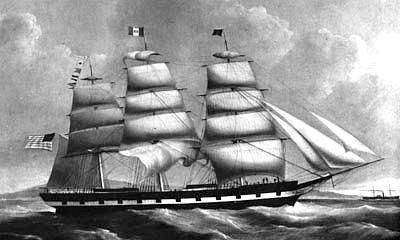
|
CARAVAN (1855)
Oil painting. 24 3/8 x 34 3/4 in. Unsigned.
Peabody Essex Museum,
Salem, Massachusetts, M11791. Gift of Nathaniel Whittier, 1964. Source:
Marion V. and Dorothy Brewington, The Marine Paintings and Drawings
in the Peabody Museum (Salem, Massachusetts: Peabody Museum, 1981),
p. 360, no. 1414. To request a larger copy of this scan, click on the
picture.
|
The U.S. ship CARAVAN was built at Bath, Maine, by Hall, Snow
& Co, in 1855, and was registered at the Port of New York on 27 May 1856.
1,362 tons; 195 ft x 38 ft 10 in x 19 ft 5 in (length x beam x depth of hold).
Sources: William Armstrong Fairburn, Merchant Sail (Center
Lovell, Maine: Fairburn Marine Educational Foundation, [1945-55]), V.3199 and
3207; Forrest R. Holdcamper, comp., List of American-flag Merchant Vessels
that received Certificates of Enrollment or Registry at the Port of New York,
1789-1867 (Record Groups 41 and 36), National Archives Publication 68-10,
Special Lists 22 (Washington, DC: National Archives and Records Service,
1968), p. 104.
[28 Mar 1998]
British ship CARDONIA [1914] -
See: D. H. WÄTJEN (1892)
|
CARL (1857)
Silk embroidery, by Thomas Willes, New York, undated (but after
1865). Sammlung Havighorst/Pawlik,
Staatsarchiv Bremen,
10 B Bildsammlung. Source: Peter-Michael Pawlik, Von der Weser in die
Welt; Die Geschichte der Segelschiffe von Weser und Lesum und ihrer
Bauwerften 1770 bis 1893, Schriften des Deutschen Schiffahrtsmuseums,
Bd. 33 (Hamburg: Kabel, c1993), p. 234.
|
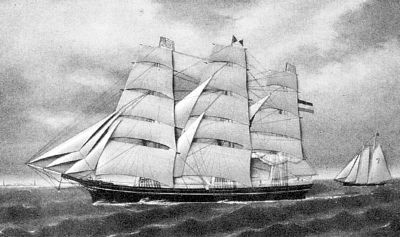
|
The Bremen ship CARL was built at Vegesack/Grohn by Johann Lange,
for the Bremen firm of E. C. Schramm & Co, and launched on 2 December
1857. 498 Commerzlasten / 1099 tons; 52,5 x 10,5 x 6,7 meters (length x beam
x depth of hold). International Signal Code: QBNS. Masters of the CARL
were, in turn, E. Lüdering, Hinrich v. Harten, Christian Friedrich Otten,
H. C. Bockelmann, and J. Hashagen. Originally engaged in the "triangle
trade" between Bremen, New York, and the cotton ports of the south, she
was transferred to the petroleum trade between North America and Europe
in the 1870's, when she ceased to carry passengers (vessels engaged in
the petroleum trade customarily did not carry passengers). In 1888, the
CARL was sold to A. Ménard, of Fiume, then in Austria-Hungary,
who first entrusted her to Capt. Michielli, but in 1890 assumed command
himself. On 6 August 1892, the CARL stranded off Little Hope
Island, Nova Scotia, and became a total loss.
Source: Peter-Michael Pawlik, Von der Weser in die Welt;
Die Geschichte der Segelschiffe von Weser und Lesum und ihrer Bauwerften
1770 bis 1893, Schriften des Deutschen Schiffahrtsmuseums, Bd. 33
(Hamburg: Kabel, c1993), p. 234, no. 238.
Voyages:
- North German (Bremen) ship CARL, [Christian Friedrich] Otten, master,
arrived at New York on 10 May 1869 (passenger manifest dated 11 May
1869), 34 days from Bremen, with merchandise and 500 passengers,
consigned to Hermann Koop & Co. "Had strong westerly winds; lat 46,
lon 45 W, saw several large icebergs; had 1 birth and 4 deaths among
the passengers."
[06 Jul 1999]
Sardinian bark CARLOTTA [1856] -
See: MAGDALENE (1847)
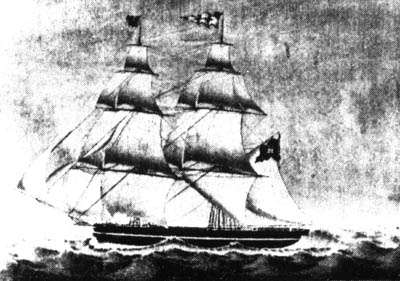
|
CAROLINE (1833)
WILHELMINE [1845]
Pen and watercolor of the Hamburg brig WILHELMINE
ex CAROLINE (British), signed J. Böttger, Altona, [1849].
Inscription: "Wilhelmine von Hamburg, geführt durch Capitain C. C.
Hansen. / Auf seiner Reise von Hamburg nach Montevidio 1849. / Die
Ansicht v. Helgoland." 52,7 x 73,6 cm.
Altonaer Museum in Hamburg -
Norddeutsches Landesmuseum, Hamburg, Inv. Nr. AB 5366. Source: Gerhard
Kaufmann, Henrik Lungagnini, and Jürgen Meyer, Die Sammlung der
Schiffsporträts, Altonaer Museum in Hamburg, Schausammlungen
des Altonaer Museums, Heft 6 (Hamburg: Altonaer Museum, [n.d.]), p. 29,
no. 11. For a copy of this picture, contact the Altonaer Museum directly.
|
The British brig CAROLINE was built on the Mediterranean island
of Malta in 1833. She appears in the annual volumes of Lloyd's Register
of Shipping for 1834/35-1841/42, which give the following details:
Tonnage: 181
Master: Holmes
Owner: Abrahms
Port of Registry: Malta (1834/35-1836/37), Liverpool (1836/37-1841/42)
Port of Survey: London (1834/35-1836/37), Liverpool (1836/37-1841/42)
The CAROLINE does not appear in the annual volumes of Lloyd's
Register for 1842/43 or the subsequent years, and I lose track of her
until 8 December 1845, when she was registered at the port of Hamburg by her
owner, Johann Marbs, who had reconstructed her (i.e., replaced all her
timbers), and renamed her WILHELMINE. The reconstructed brig measured
84 x 24.2 x 14.2 Hamburg Fuß (1 Hamburg Fuß = .28657 meter), length x beam
x depth of hold, with a cargo capacity of 72 Commerzlasten.
Masters:
1845-1849 - C. Bähr
1849-1851 - C. C. Hansen
1851-1856 - P. R. Stiige
Voyages:
1845/46 - Liverpool/Havana
1846/47 - New York/intermediate ports/Hartlepool
1847/48 - Cape Verde Island/Santos
1848/49 - Ciudad Bolivar/Bremen
1849/50 - La Plata/intermediate ports/Buenos Aires
1851/52 - Buenos Aires/Rotterdam/intermediate ports/Hartlepool
1852/53 - Buenos Aires/intermediate ports/Rio de Janeiro
1854-1856 - La Plata/intermediate ports/London
On 12 June 1856, Marbs sold the WILHELMINE to the Hamburg shipowner
Jonas Gabriel Lund.
Masters:
1856-1858 - P. R. Stiige
1858-1863 - J. H. Schultz
Voyages:
1856 - Hartlepool (5 x)
1857/58 - Buenos Aires/intermediate ports/Hartlepool
1858 - England
1858/59 - Lagos
1859/60 - Bahia
1860-1862 - Newport, Wales/intermediate ports/Trinidad
1862 - Veracruz/Altona
1863 - Santo Domingo
Om 1863, Lund sold the WILHELMINE ex CAROLINE on the island
of St. Thomas. I know nothing further of her history, or of her ultimate
fate.
Source: Walter Kresse, ed., Seeschiffs-Verzeichnis der
Hamburger Reedereien, 1824-1888, Mitteilungen aus dem Museum für
Hamburgische Geschichte, N. F., Bd. 5 (Hamburg: Museum für Hamburgische
Geschichte, 1969), vol. 2, pp. 27-28 and 35.
[23 Oct 1997]




